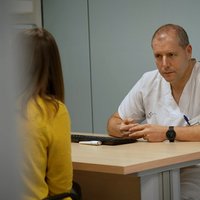From the workshop to the asphalt
Crankcase, crankshaft, pistons, spark plugs, valves... The combination of all these parts completes the motor of an automobile, that is, the one that starts when we deliver it to the contact key.
But for the engine to work, it needs fuel, the food that will start the engine.
Although everyone is talking about an electric car, the hydrogen engine could also be an alternative to the current fossil fuels, a path that the automotive workshop of the Public University of Navarra is working on. They're adapting the gasoline engine to run on hydrogen.
The original gasoline engine has undergone major changes in its control and in its feeding and cooling system.
PEDRO DIEGUEZ; UPNA: The injectors had to go from injecting liquid to injecting gas. So we've installed gas injectors. The gas has a larger volume and has a slightly different control. That is, the main change has been the fuel supply system.
And then, above all, control. The combustion of gasoline is very different from the combustion of hydrogen. For this reason, we have had to modify all the electronic parameters of the injection time, when to inject, etc., but this requires special software programming in the control that manages the motor of the car.
The first tests in the test room have already been carried out by the engineers working on the project, and the results have been satisfactory, although the power decreases slightly compared to the gasoline engine.
The engine used belonged to a Volkswagen Polo, which reached 5,000 revolutions per minute and reached a speed of 140 kilometres per hour.
It has been an important step, since hydrogen, which is an exhausting fuel, can be easily obtained from water and when it is burned does not emit contagious substances or cause a greenhouse effect.
Since it is a gas, hydrogen will be introduced into the vats.
PEDRO DIEGUEZ; UPNA: There was a time when butane cylinders used to change in homes, so the system would be the same. We're changing the hydrogen cylinders here. I mean, we're not going to fill it, but we're going to change the bottle or the bottle. When it’s empty, remove it and replace it with a full one.
In the prototype being made, three steel bottles will be used. Each one will have a capacity of 18 litres and an autonomy of 140 kilometers, depending, of course, on the way of driving.
It will be a hybrid model, so the pieces will be duplicated. On the one hand, those relating to gasoline, on the other, those relating to hydrogen. In this way, the driver will choose to use one or the other fuel at any given time.
By the end of the year, the project will be completed. It will be several years before we see these first cars on the road. Such vehicles shall not cause pollution, at least as far as combustion is concerned. But they will produce a different kind of pollution, that is, sound pollution.
Engine, exhaust pipe, body vibration, contact between wheels and asphalt. Bigger or smaller, they all have noise.
The law sets the noise limit at 55 decibels per day and 45 decibels per night. But these limits are often exceeded.
The acoustics team of the Department of Physics of the Public University of Navarra has carried out different tasks to obtain quieter cars.
MIGUEL ARANA; UPNA: We, for example, have done some work, specifically to reduce the sound of the servo-brakes, and the truth is that with very simple measures we obtained quite good results.
A common protector that we made with glass fiber made the sound quite small. In addition, it cost only 2 euros per system, that is, each car, and the high frequency sound level dropped considerably.
The way forward, therefore, is to improve the parts one by one: a good tyre design, exhaust pipe design or engine protection are some of the options.
But there is also the other side of the coin, the noise generated by traffic in general. In order to make improvements, it is necessary to know the effect of this noise from area to area. Heretofore, physical measurement has been used, but this method is time consuming and labor intensive, and is expensive.
Computers are used to make measurements. The acoustic conditions of the ground and the data of all the noise sources are entered into the computer and, through a program, they obtain the noise data of the place, as well as some solutions such as screens for noise protection.
MIGUEL ARANA; UPNA: We see how the isophones are formed. Where there are screens, the effect of the sound decreases. Initially, sound and waves enter the entire urbanization when they reach the fence, the fence protects the buildings, thus achieving the objective of quality.
The answers to the different situations are also different: the installation of arcuate screens of noise is the solution they choose on the motorways. But in urban areas, the option could be to slow down or turn the streets into pedestrians.
The project team of the Department of Agriculture and Renewable Engineering has another option on their hands: changing the asphalt of the roads. In this project, the waste generated in the works is used as raw material.
ANGEL SECO; UPNA: When the material reaches us, we first dry it in the laboratory and then crush it to achieve homogenization. We leave it in detail for use in laboratory tests.
The manufacturing process is very precise. To a specified amount of material, well-weighed additives are added. They can be conventional additives such as lime or cement, or unusual additives such as waste from thermal power plants or other industries. To homogenize the mixture, a small amount of water is added and the mass is compacted.
The sample is cured in a chamber and then subjected to a pressure test to calculate the strength.
ANGEL SECO; UPNA: We'll take the test piece out on the corresponding day of the breakup, and we'll take it to the press to break it. There we will see how the resistance increases according to the time that has passed.
You can see how it conforms, and how, in the end, the test piece doesn’t resist any more.
The tests are carried out with different mixing and curing times until the most suitable is obtained.
The result can be used for the construction of infrastructures and the renovation of damaged roads.
ANGEL SECO; UPNA: In road renovation works, you can add products and do the work there.
In this case, the deteriorated path would be reduced until the material is shredded and, by adding the additive and water, it would be compacted therein.
Achieving the re-use of these wastes would not only improve the material currently used in asphalt, but would also result in the removal of large volumes of wastes, i.e. wastes that cost producers and are an environmental problem.
Buletina
Bidali zure helbide elektronikoa eta jaso asteroko buletina zure sarrera-ontzian











